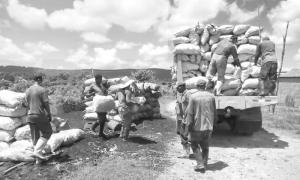
Matanzas.- When the charcoal is put into the sacks, some of the burners are surprised by the metallic sound it makes and by its shiny black color.
It is a charcoal made from sicklebush, a natural fuel in great demand on the international market, produced in charcoal piles in different parts of the country.
According to experts, it is in great demand mainly because of its excellent energy power, high yield and the fact that it does not harm the environment, in addition to other minor characteristics such as stability of the fire, absence of ash and other particles.
This is the opinion of engineer Lidaimi Herrera, a specialist at Matanzas Agroforestry Company (AFM), one of the leading exporters of this product in Cuba.
THE TOUGH WORK OF CHARCOAL BURNERS
As the aphorism goes, “all that glitters is not gold”, and all that seems wonderful does not turn out to be so.
"Producing charcoal, especially from sicklebush, is a very hard work, and few are willing to face the challenges of this labor", says Rafael Alberto Ramírez Carrera, a self-employed worker and one of the most prominent producers, who has a contract with the Matanzas’ company for this important commodity.
To get to his farm, located about ten kilometers from the central highway, in an area of the municipality of Limonar known as Chacón, it is necessary to travel on roads that are difficult to access.
People usually travel on carriages. It is quite a dilemma to get there with trucks to transport the sacks of coal.
"I have been involved in charcoal production since I was very young and I deliver about a hundred tons a year with the help of six other workers from here. It is difficult but profitable."
Alberto Ramírez explains that the Company covers the cost of the sacks and the transportation of the product, and that for each ton of charcoal (50 standard polypropylene sacks weighing about 20 kilograms) they receive about 200 MLC (freely convertible money).
He admits that in the current year he is maintaining a steady pace, although there are often obstacles with the sacks and fuel, which slows down delivery.
Yan Carlos Fernández Ramírez, one of Rafael's closest collaborators, explains that making charcoal is extremely difficult.
"Everything is difficult, from cutting it, to loading it, to burning it in the pile, and then doing the processing to ensure the highest quality product. Plus, we don't always have the proper outfit."
ADVANTAGES OF SICKLEBUSH
Jorge Díaz Mirabal, general director of the AFM, assures that it will be very difficult for them to reach this year's 1,400 tons for export, but he assures that they have already shipped the first 390 tons and that it is possible to finish 2024 with an amount close to one thousand, as was the case last year.
In order to achieve this goal and to place the charcoal from sicklebush on foreign markets, they are counting above all on the contribution of their best producers, located in the municipalities of Los Arabos and Martí.
Such a goal, together with the achievement of other productivity indicators, would maintain the company's position as one of the first exporters of this product in the country.
The businessman pointed out that charcoal from sicklebush is also in great demand due to the absence of smoke and bad smell during combustion.
According to official figures, Cuba produces around 40,000 tons of charcoal each year to meet domestic demand and cover foreign sales.
Experts emphasize the quality of this product and its multiple uses as a fuel, both industrial and domestic, as well as its use in the gastronomic sector for the distinctive flavor it gives to food.
There are those who rejoice in the fruit of the sicklebush, an invasive plant on the Island that overruns many Cuban fields and whose presence limits food production.
What has been proven is that it is used to make charcoal of very good quality and that, although it is not gold, it does shine.















